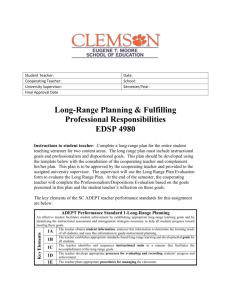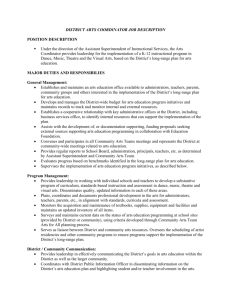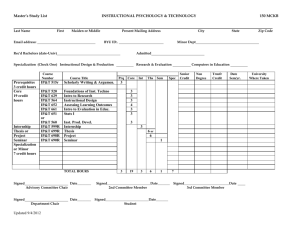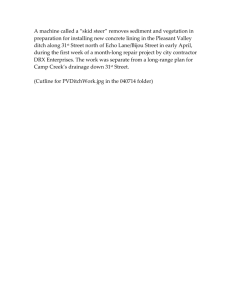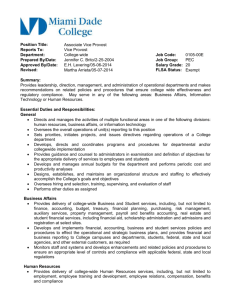ADEPT APS 1 - Domain 1: Long-Range Plan ADEPT Performance
advertisement
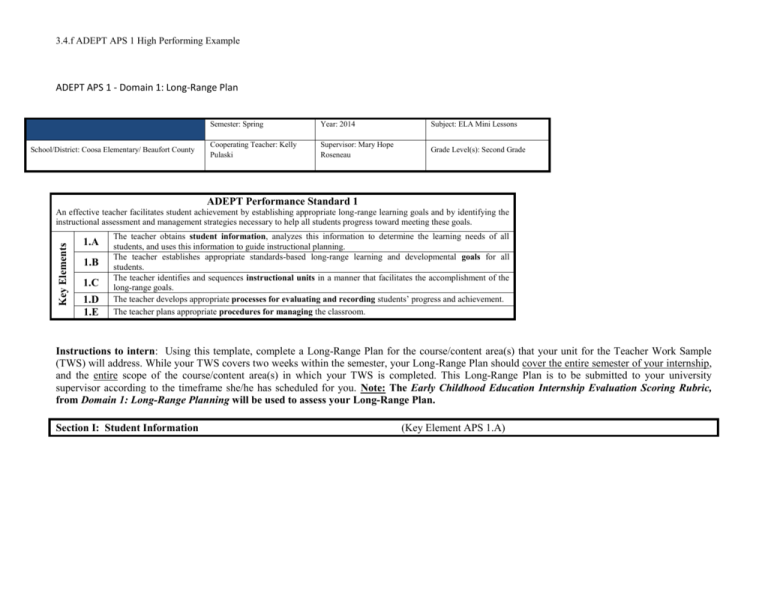
3.4.f ADEPT APS 1 High Performing Example ADEPT APS 1 - Domain 1: Long-Range Plan Candidate: Katey Rentz Semester: Spring Year: 2014 Subject: ELA Mini Lessons School/District: Coosa Elementary/ Beaufort County Cooperating Teacher: Kelly Pulaski Supervisor: Mary Hope Roseneau Grade Level(s): Second Grade ADEPT Performance Standard 1 Key Elements An effective teacher facilitates student achievement by establishing appropriate long-range learning goals and by identifying the instructional assessment and management strategies necessary to help all students progress toward meeting these goals. 1.A 1.B 1.C 1.D 1.E The teacher obtains student information, analyzes this information to determine the learning needs of all students, and uses this information to guide instructional planning. The teacher establishes appropriate standards-based long-range learning and developmental goals for all students. The teacher identifies and sequences instructional units in a manner that facilitates the accomplishment of the long-range goals. The teacher develops appropriate processes for evaluating and recording students’ progress and achievement. The teacher plans appropriate procedures for managing the classroom. Instructions to intern: Using this template, complete a Long-Range Plan for the course/content area(s) that your unit for the Teacher Work Sample (TWS) will address. While your TWS covers two weeks within the semester, your Long-Range Plan should cover the entire semester of your internship, and the entire scope of the course/content area(s) in which your TWS is completed. This Long-Range Plan is to be submitted to your university supervisor according to the timeframe she/he has scheduled for you. Note: The Early Childhood Education Internship Evaluation Scoring Rubric, from Domain 1: Long-Range Planning will be used to assess your Long-Range Plan. Section I: Student Information (Key Element APS 1.A) Internship *Student Number USCB Languag Relevant Special Interests or Reading e(s) Cultural Hobbies Level spoken Background (Student Interview, Scores and Info ** at home Interest Inventory) Test Used 1 English 2 | 3 | 4 | 5 | 6 | 7 | 8 | Basketball Long-Range Plan Math Level Differentiation Scores and Test Used Needs 195/above 207/above 165/below 173/below Playing on the phone 204/above 202/above Trains 203/above 212/above 186/onlevel 195/above Playing with pig 188/onlevel 193/above Snowboarding 199/above 197/above Staring eye contest 195/above 201/above Military (IEP, ELL, G/T) Other Relevant Student Information RTI SIT Process Speech Allergies to dairy, nuts Military cheese. Also 2 Internship USCB Long-Range Plan has asthma 9 | Basketball 10 | 11 English & Spanish 12 English Vietnamese 145/below 165/below 192/above 200/above 159/below 169/below RTI X SIT Process Football 158/below 155/below RTI X SIT Process Soccer 190/onlevel 207/above 173/below 179/below Playing Xbox 182/onlevel 191/above Hispanic 13 | Indian 14 | Military 15 | 16 | Military Football 169/below 193/above 17 | Military Making jelly bracelets 190/onlevel 201/above 18 | Military 19 | 20 | Military Playing PlayStation 193/above ODD RTI SIT Process (Parents Request) 187/on-level Watching TV 179/onlevel 185/on-level Playing with the dog 203/above 207/above ADHD and retained 3 Internship 21 USCB | Auburn football Long-Range Plan 171/below 177/below Section II: Learning and Developmental Goals (Key Element APS 1.B) List the major goals from the course/content area(s) that you are outlining. Goals By the end of the unit, the student will be able to identify the common characteristics of a fairytale, fable, and folktale. By the end of the unit, the student will be able to determine the central message, lesson, or moral of a given text. Be the end of the unit, the student will be able to compare and contrast two versions of the same story by different authors or from different cultures. Section III: Instructional Units and Assessments (Key Elements APS 1.C) In chronological order, list the units as they will occur in this course/content area(s) in the table below. Indicate in bold the Unit Topic or Title that is your Teacher Work Sample. Unit Topic or Title Correlated Standards Non-fiction Text Features Biographies CCSS.RI.2.5, W.2.5 Point of View CCSS. RL.2.6, Comparing and Contrasting CCSS. RI.2.6, RI.2.9 Fairytales, Fables, and Folktales CCSS.RL.2.1, RL.2.2, RL.2.3, RL.2.7, RL.2.9 CCSS.RL.2.3, RI.2.6, RF.2.3, Length (# days or weeks) 4 weeks (January 6February 4) 2 weeks (February 5February 21) Assessment(s) (e.g., projects, quizzes, chapter/unit tests, homework assignments. Include weightings, if applicable.) 1 week (February 24Februaury 28) 1 week (March 3-March 7) 1) Non-fiction text poster match up. 2) Non-fiction text scavenger hunt. 1) Biography Book Buddy 2) Biography Book Report 3) “All about Me” autobiography book 1) Which point of view activity 2) First person Flip Book. 1) Venn Diagram 2) T-Chart 2 weeks (March 10March 21) 1) Fairytale Flip book 2) Fable reading and response questions. 4 Internship Unit Topic or Title USCB Correlated Standards Long-Range Plan Length (# days or weeks) Assessment(s) (e.g., projects, quizzes, chapter/unit tests, homework assignments. Include weightings, if applicable.) 3) Folktales around the world. Section IV: Assessment Data (Key Element APS 1.D) Describe your methods in this course/content area(s) for analyzing, evaluating, recording, and reporting student progress and achievement. A variety of assessments will be used throughout the two-week unit to analyze, evaluate, and record student’s growth. There will be several formative assessments throughout the unit to gage the amount of knowledge students are gaining. Some of these assessments will include class discussions, Promethean board activities, splash webs, and Venn diagrams. During the entirety of the unit I will be monitoring their progress and making adjustments as needed. For the summative assessments there will be three main assessments for each genre. For fairytales students will be creating a flipbook that gages their knowledge of the different characteristics of a fairytale. For fables, students will complete a reading and response activity where they must find the moral of the story. During the folktales portion of this unit students will complete a folktale around the world activity where they will compare a contrast the different folktales. The assessment tools that will be used during this unit will include observations, performance assessment, and project/demonstration. For the assessments that will be used for a grade, they will be recorded into a regular grade book and then eventually transferred into an electronic grade book. In order to report student’s progress during this unit a variety of way will be used. For students, they will receive their graded work every Friday to take home. There will also be one on one conference for any students who may be struggling. Parents have many portals to keep track of their student’s progress. Every parent has access to his or her student’s grade book online and it is available at all times. Parents will also receive progress reports and report cards, have parent-teacher conferences, and all the work their students complete will be sent home every Friday. Administration may ask for grades at any point. They will be given students graded work and any anecdotal notes taken on that particular student. They too have access to the electronic grade book and they may ask for any other grades they need. Any progress report or report card sent home would first be sent to administration. All students’ progress will be made available to any authorized personal. Section V: Classroom Management (Key Element APS 1.E) Insert your classroom management plan or rules, which should include your expectations regarding student behavior during instructional and noninstructional procedures and routines. Highlight the specific management demands of the course/content area(s) for this Long-Range Plan. 5 Internship USCB Long-Range Plan Behavior Discipline Plan For the overall behavior discipline plan, each child in the classroom has his/her name written on a clothespin. This clothespin is placed on the green light at the beginning of each day. The first rule of infraction is a verbal warning. The second on is that the child’s clothespin will be moved to yellow light. The third rule of infraction is that the child’s clothespin will be moved to red. The child loses some recess time and his/her good behavior point. Behavior points are given twice in one day, one for good behavior in the morning and one for good behavior in the afternoon. If students get on red then his/her behavior point if taken and on Fridays when bob bucks are given out they will only receive one instead of two. The behavior points are tracked by push pin on a cork board, each student has his/her own paw print and everyday the correct number of push pins are added under the students names. At the end of the week the points are added up and a reward is given to each child that has earned nine or ten good behavior points. If there is severe disruption it will result in an immediate referral to the school administration. Non-Instructional As students move about the school to all the different areas there are several procedures they must follow. In order to line up, students wait for their table number to be called and then they may line up quickly in the hallway. The leader of the day is always the line leader. Once out in the hallway students know to walk quietly without leaning on the walls. For recess students are free to play on the playground equipment, basketball court and in the backfield area. Students are aware not to go beyond the fences. If a ball or something gets thrown across the fence the students will come get a teacher to go get it. When recess is coming to a close the whistle will blow and all the second grade will come to the front of the playground and line up according to which class they are in. Once teachers completed a count of students the first class moves to the door and the rest of the grade proceeds to follow. From there the students walk into the cafeteria where they stay lined up according to class. The first class goes into the lunch line while the other classes wait right outside the line. Once one class is finished another one will follow. The first ten minutes of lunch is silent lunch. This allows students to eat their lunch instead of talking the whole time. Once the ten minutes are up the leader of the day goes to each table, just in our class, and switches the cups on the table from yellow to green. When lunch is over they clear off their trays, silently line up and proceed back to the classroom to continue the instructional day. Instructional My two-week unit will be taught during the Daily 5. During Daily 5 there are specific expectations students have during each activity and they are to follow the normal classroom rules which are, Be Respectful, Be Productive, Be Safe, and Be prepared. During the focus mini lessons the students will either be at the carpet or at their desks. During this time the normal classroom rules are in effective and the behavior discipline plan will be followed if there are any disruptions. Once the focus mini lesson is complete the students will be released to go into their Daily 5 activity. During these activities there are specific rules the students must follow on top of the normal classroom rules. The rules are as follows: Read to Self 6 Internship USCB Long-Range Plan -Read silently or quietly to yourself. -Don’t sit next to someone you will talk to. -Read the whole time. -Stay in one spot. -Read “just right” books. -Build Stamina. -Find your reading spot quickly. Read to Someone -Sit EEKK (elbow to elbow and knee to knee) -Level 1 voice -Read the whole time. - Stay in one spot. -Get started right away. Work on Writing -Write the whole time. -Check your work. -Stay in one spot. - Get started quickly. -Circle unknown words. -Work quietly. Word Work -One person takes out his or her materials and sets up in a quiet location. -Work the whole time. -Build Stamina - Find your spot quickly and get started right away. -Stay in one spot the whole time. -Three people to one area. Listen to Reading -Get out materials quickly. -Listen to the whole story. -Follow along with the book. -Stay in one spot. -Listen quietly. -Put materials back in the proper manner. Once the first rotation of Daily 5 is complete a whistle will be blown and students will be directed to their seats or to the carpet for the second focus mini lesson. When the mini-lesson is complete another round of Daily 5 begins. Each Daily 5 rotation should last about 15-20 7 Internship USCB Long-Range Plan minutes and the focus mini-lessons will be only about 10-15 minutes. While students are at their Daily 5 activities I will be working with a guided reading group. During these groups we will be working on specific skills based on the groups reading level. For example groups one and two are still focusing on chunking words and practicing common sight words and high frequency words. Groups three and four are more focused on comprehension and vocabulary skills. During each of these groups the expectations are the same as normal classroom rules. Students that are working in these groups understand that their voices levels may not get to high because the rest of the class is working on other things. Once the last rotation is complete a whistle will be blown, students will clean up their area, go back to their seats, and wait quietly for their instructions. Instructions to University Supervisor: After evaluating the intern’s Long-Range Plan (using the Early Childhood Education Internship Evaluation Scoring Rubric, from Domain 1: Long-Range Planning), circle the appropriate performance level below. Exceeds Expectations Supervisor signature: Circle one Supervisor name: Date: Meets Expectations Does Not Meet Expectations Adapted from Winthrop University’s Long Range Plan (2009) and SAFE-T, March 2008, SCDOE on 8.19.08 8 Internship USCB Long-Range Plan Domain 1 - Long-Range Planning Rubric Exceeds Expectations (3 pts) Meets Expectations (2 pts) Does Not Meet Expectations (1 pt) Domain 1: LONG-RANGE PLANNING 1. Uses contextual factors to develop longrange goals and to guide instructional planning. (1.000, 20%) NAEYC-INI2010.5.c SC-ADEPT-06.1.A SC-USCB-CECF.FI.9 SC-USCB-CE-CF.N.3 Teacher candidate analyzes relevant contextual factors (e.g., informal and formal assessment data, prior achievement levels, learning styles and needs, interests, cultural or ethnic origins) to make direct connections to long-range goals and instructional plans. Teacher candidate references contextual factors (e.g., both informal and formal assessment data, prior achievement levels, learning styles and needs, cultural and socioeconomic backgrounds, and individual interests) to develop long-range goals and guide instructional planning. Teacher candidate does not demonstrate an understanding of contextual factors and long-range goals chosen Long-range goals are unrelated to contextual factors. 2. Establishes appropriate standardsbased long-range learning and developmental goals for internship. (1.000, 20%) NAEYC-INI-2010.5.a SCADEPT-06.1.B SC-USCB-CE-CF.FI.11 Unit goal(s) is/are measurable, aligned with state and/or national standards, and reflect the appropriate level of difficulty for the range of students in the classroom. Unit goal(s) is/are measureable and aligned with state and/or national standards. Unit goal(s) is/are not measurable and fail to align with state and/or national standards. 3. Identifies and sequences instructional units in a manner that facilitates the accomplishment of long-range goals for internship. (1.000, 20%) NAEYC-INI2010.5.c SC-ADEPT-06.1.C SC-USCB-CECF.FI.10 Instructional units are logically sequenced and aligned with long-range goals. Teacher candidate provides a progressive and logical set of integrated lessons (scope and sequence). Instructional units are logically sequenced and aligned with developmental long-range goals. Teacher candidate provides a progressive and logical set of lessons (scope and sequence). Instructional units are not aligned with developmental longrange goals. Teacher candidate fails to provide a progressive and logical set of lessons (scope and sequence). 4. Plans strategies for evaluating and recording students' progress and achievement and communicating achievement results to students. (1.000, 20%) NAEYC-INI-2010.3.c SC-ADEPT06.1.D SC-USCB-CE-CF.FI.13 Strategies for evaluating student progress (e.g., observations, performance projects, portfolios and other appropriate assessments) include well-organized plans for communicating achievement results on a regular basis to students in an appropriate manner. Strategies for evaluating student progress (e.g., observations, performance projects, portfolios and other appropriate assessments) include plans for communicating achievement results to students in an Teacher candidate plans strategies for evaluating student progress; however, communication to students is limited to the use of report cards. 9 Internship USCB Long-Range Plan Domain 1 - Long-Range Planning Rubric Exceeds Expectations (3 pts) Meets Expectations (2 pts) Does Not Meet Expectations (1 pt) appropriate manner. 5. Plans appropriate procedures for managing the classroom that promotes positive behaviors and maximizes instructional time. (1.000, 20%) NAEYCINI-2010.3.b SC-ADEPT-06.1.E SC-USCBCE-CF.FI.13 Teacher candidate plans specific proactive management procedures that promote positive classroom behaviors and provides explicit instruction on transitions and routines and positively stated classroom rules. Teacher candidate plans appropriate management procedures that promote positive classroom behaviors and transitions and routines that maximize instructional time, and positively stated classroom rules. Teacher candidate plans general classroom management techniques that do not maximize instructional time and/or rules and/or routines are not identified in the plan. Overall Total Score Exceeds Expectations Meets Expectations Does Not Meet Expectations 10
